Note: This publication is currently undergoing major revisions. The current publication will be replaced with a new publication based on stakeholder requirements and scientific advances. We expect to begin sharing details on this soon. If you have input on content, format, or publication frequency at any time, please contact us at cbrfc.webmasters@noaa.gov.Green Water Supply Outlook, March 1, 2011Green Water Supply Outlook, March 1, 2011
Contents
Green Summary
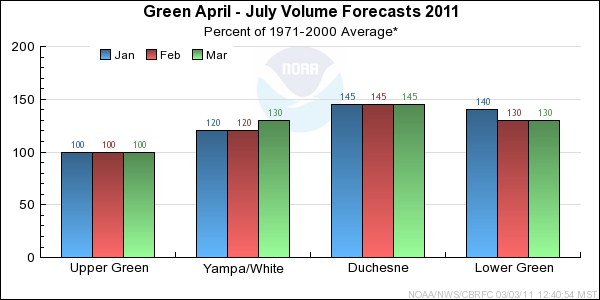
*Median of forecasts within each basin.
Upper Green Basin Conditions
The following conditions influenced this month's forecasts:
Precipitation:
Seasonal October through February
precipitation was 130 percent of average
in the Upper Green basin. February
precipitation was 115 percent of average in
the basin as a whole; however, portions of the basin such as the headwaters of the Blacks Fork River received
near 130 percent of avearge precipitation in February.
Snow:
March 1st snow water equivalent was 115 percent of average in the basin.
--- Upper Green basin
snow
water equivalent plot.
Streamflow:
February streamflow was near 80 percent of average.
Soil Moisture:
Modeled
soil
moisture states were below average heading into the winter.
Climate Forecasts:
Climate forecasts were not a factor because there is not a strong correlation
between La Nina conditions and winter precipitation in the Upper Green basin.
Forecast Summary:
With the addition of above average precipitation for February, the
seasonal precipitation and snow water equivalent still remain much above
average and above average, respectively. As a result of the current conditions,
the April through July streamflow volume forecasts are the same as the February
forecasts or have increased slightly. Current forecasts range between 100 and 124
percent of average with a median value of 102 percent.
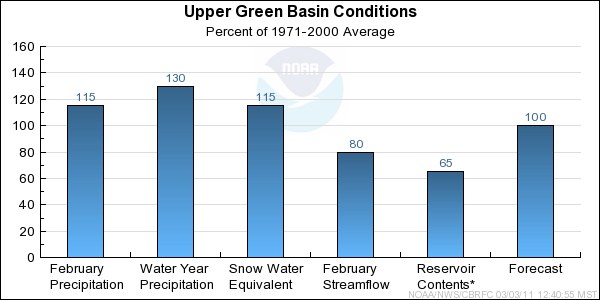
* Percent usable capacity, not percent average contents.
Click for multi-month Graph.
Yampa/White Basin Conditions
The following conditions influenced this month's forecasts:
Precipitation:
Seasonal October through February
precipitation was 135 percent of average
in the Yampa/White basin. February
precipitation was 115 percent of average in
the basin as a whole.
Snow:
March 1st snow water equivalent was 125 percent of average in the basin.
--- Yampa basin
snow
water equivalent plot.
Streamflow:
February streamflow was near 80 percent of average.
Soil Moisture:
Modeled
soil
moisture states were near average heading into the winter for the Yampa, Little Snake,and
White River basins.
Climate Forecasts:
Climate forecasts were not a factor in the forecasts because there is not a strong correlation
between La Nina conditions and winter precipitation in the Yampa/White basin.
Forecast Summary:
With the addition of above average precipitation in February,
the seasonal precipitation and current snow water equivalent remain
much above average and above average, respectively.
It is also important to note that many of the snotel locations have
already surpassed the average seasonal peak. As a result of the current conditions,
the April through July streamflow volume forecasts are similar to the February
forecasts or have increased by approximately 5 to 8 percent. Current forecasts
range between 108 and 138 percent of average with a median value of 127 percent.
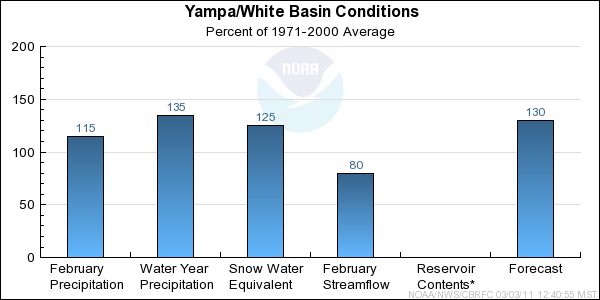
* Percent usable capacity, not percent average contents.
Click for multi-month Graph.
Duchesne Basin Conditions
The following conditions influenced this month's forecasts:
Precipitation:
Seasonal October through February
precipitation was 170 percent of average
in the Duchesne basin. February
precipitation was 140 percent of average.
Snow:
March 1st snow water equivalent was 150 percent of average in the basin.
--- Duchesne basin
snow
water equivalent plot.
Streamflow:
February streamflow was 90 percent of average.
Soil Moisture:
Modeled
soil
moisture states were much below average to below average heading into the winter.
Climate Forecasts:
Climate forecasts were not a factor in the forecasts because there is not a strong correlation
between La Nina conditions and winter precipitation in the Duchesne basin.
Forecast Summary:
With the addition of much above average precipitation in February,
the seasonal precipitation and current snow water equivalent remain
much above average. It is also important to note that the majority
of snotel locations in the basin have already surpassed the average
seasonal peak. As a result of the current conditions, the April through
July streamflow volume forecasts are similar to the February forecasts
or have increased by approximately 5 to 10 percent. Current forecasts
range between 115 and 182 percent of average with a median value of 145 percent.
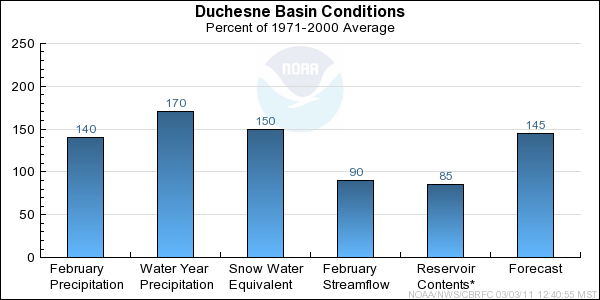
* Percent usable capacity, not percent average contents.
Click for multi-month Graph.
Lower Green Basin Conditions
The following conditions influenced this month's forecasts:
Precipitation:
Seasonal October through February
precipitation was 180 percent of average
in the Lower Green basin. February
precipitation was 120 percent of average.
Snow:
March 1st snow water equivalent was 120 percent of average in the basin
as a whole.
--- Lower Green basin
snow
water equivalent plot.
Streamflow:
February streamflow was near 95 percent of average.
Soil Moisture:
Modeled
soil
moisture states were much below to near average heading into the winter.
Climate Forecasts:
Climate forecasts were not a factor in the forecasts because there is not a strong correlation
between La Nina conditions and winter precipitation in the Lower Green basin.
Forecast Summary:
With the addition of above average precipitation in February,
the seasonal precipitation and current snow water equivalent remain much
above average and above average, respectively. As a result of the current
conditions, the April through July streamflow volume forecasts are similar
to the February forecasts. Current forecasts range between 121 and 151 percent
of average with a median value of 129 percent.
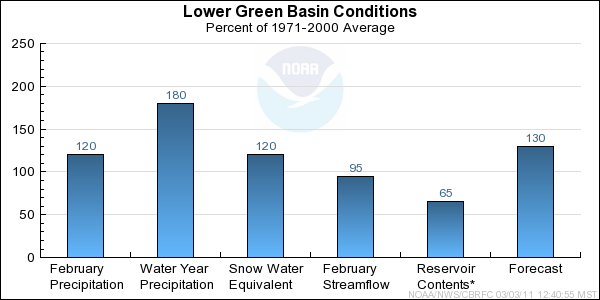
* Percent usable capacity, not percent average contents.
Click for multi-month Graph.
Differences between the full period forecasts and the residual forecasts may not exactly equal the actual observed volumes due to rounding conventions (see Definitions section).
Reservoir Monthly Inflow Forecasts
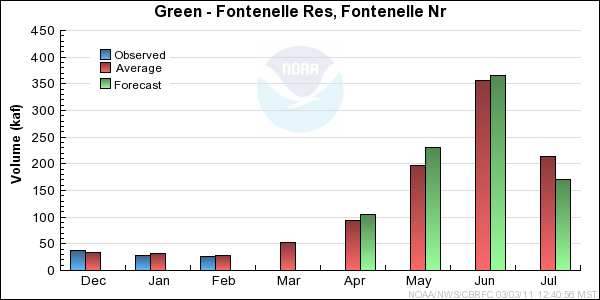
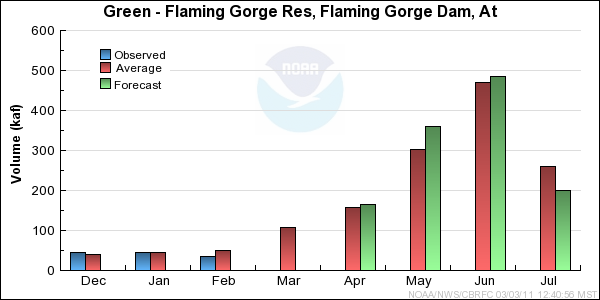
Monthly Streamflows
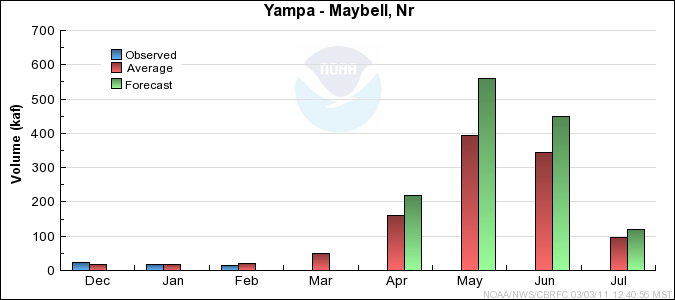
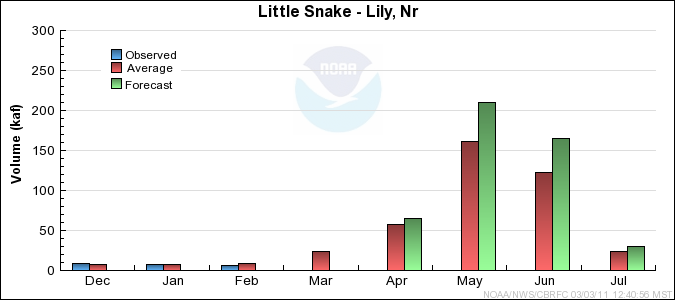
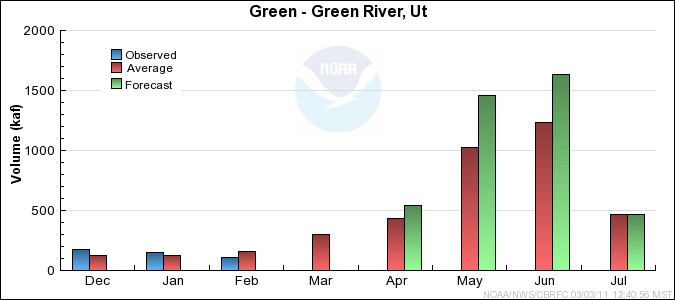
Precipitation Maps
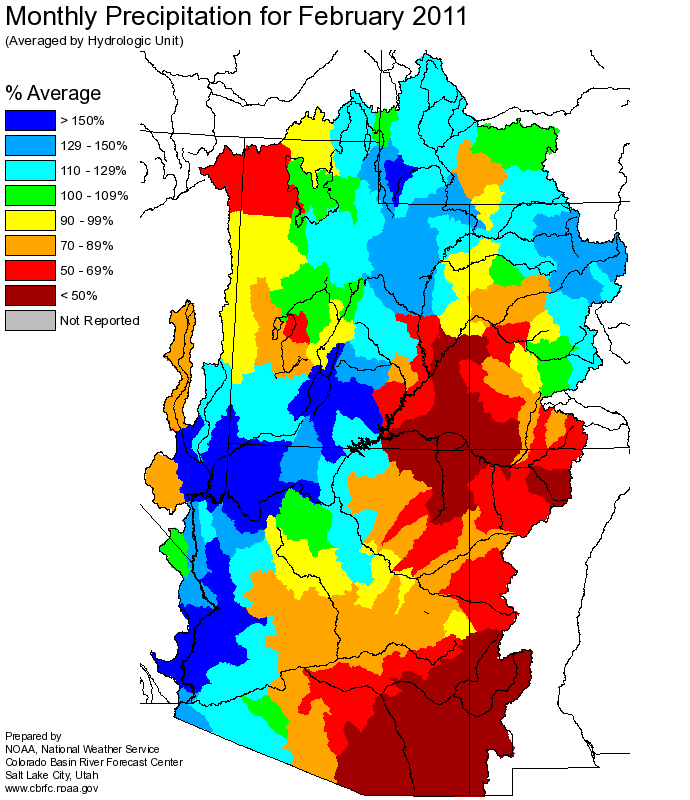
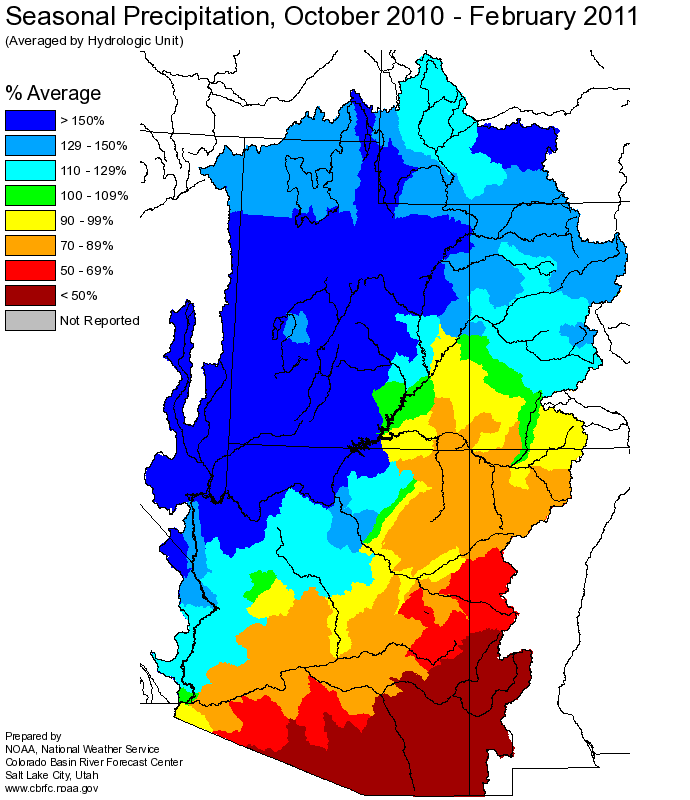
Hydrologist: Ashley Nielson













